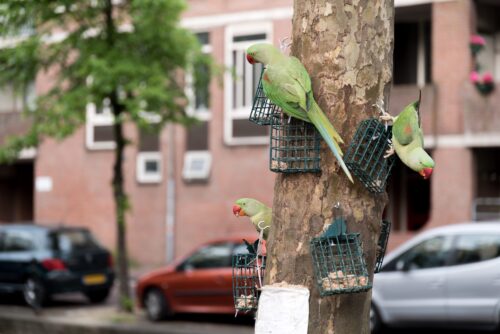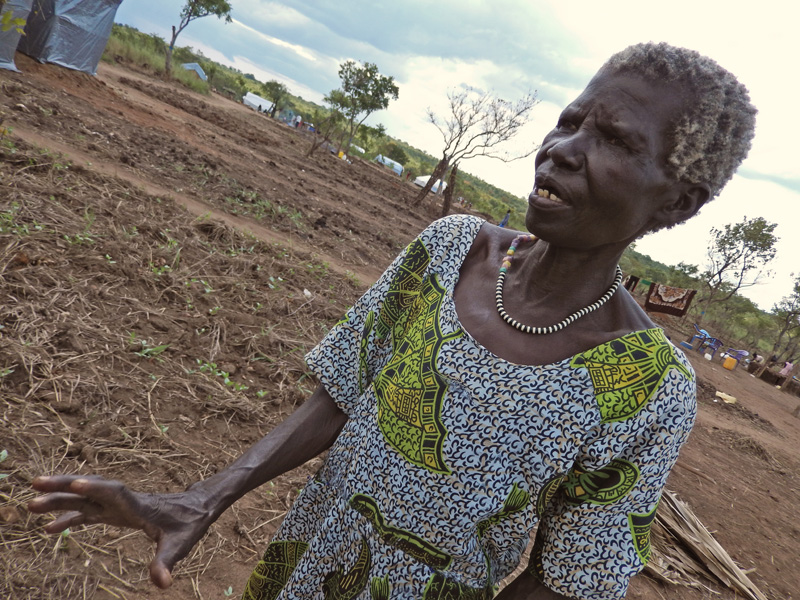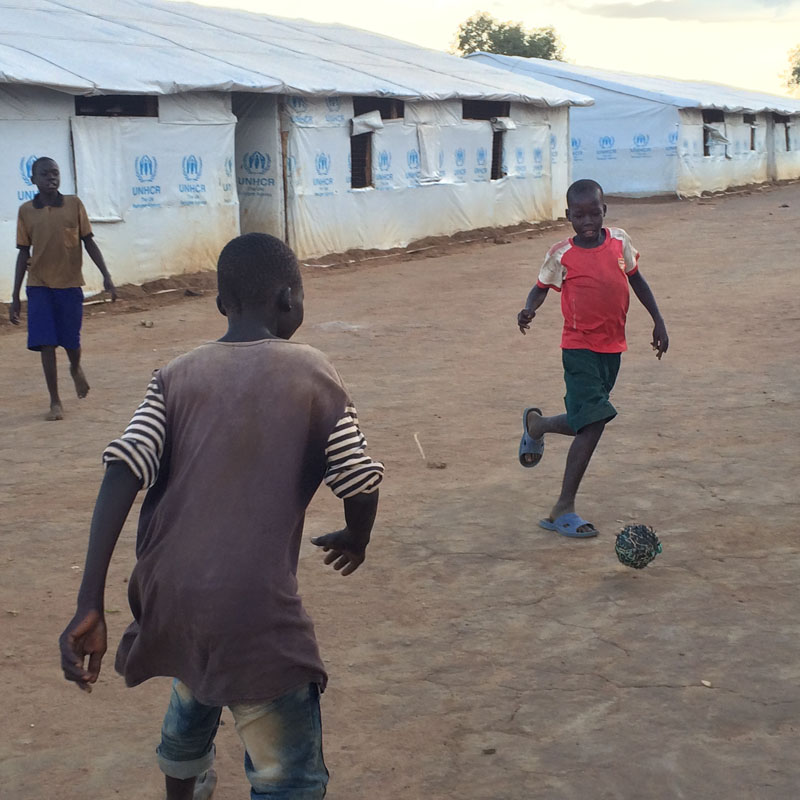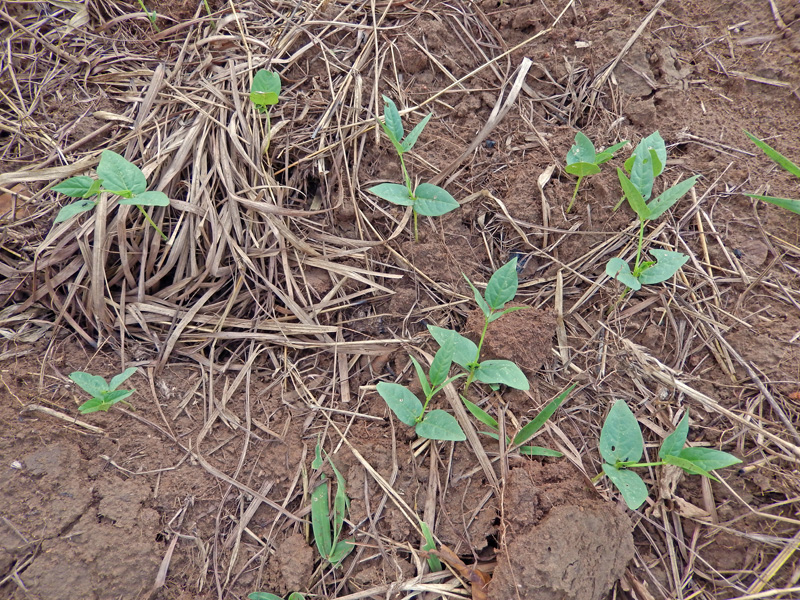South Sudanese Refugees and the Taste of Displacement
Katarin Ladu is tall and thin, with short, curled hair and a face wrinkled by sunshine, age, and worry. She wears a beaded necklace, a mismatched pair of flip-flops, and a long, loose dress with intricate patterns on it. I follow her a quarter-mile along a red-dirt path that leads from the United Nations tent where she lives to the soil where she is making a garden. “This is my plot,” she says, pointing to a small patch of straw-covered earth where tiny green pea leaves are beginning to emerge. “They are not yet ready for eating,” Ladu says. But when they are, she explains, she will pluck the leaves, boil them with salt, chop them, and—this is her dream—mix them with a paste of groundnuts (peanuts) and sesame seeds.
But that simple dream is unlikely. As a South Sudanese refugee living in a settlement in northern Uganda, Ladu relies on monthly rations provided by the World Food Program (WFP): maize, beans, sorghum, corn-soy blend, oil, and salt. G-nut paste (as locals call it) and simsim (the term for sesame) are scarce for most refugees.
Unlike many countries, Uganda allows refugees to work inside and outside the settlements. But it takes capital to start a business, and many refugees don’t have it. And it can take years for a business to start generating income. Consequently, hundreds of thousands of families rely heavily on food rations. They have no way to obtain G-nut paste or simsim, which are staples in the traditional diets of both South Sudan and northern Uganda. “I cannot afford to eat that way,” Ladu says.
Not only has Ladu lost her home and her independence, she’s lost the flavors that connect her to her previous life. Day in and day out, refugees relinquish a bit of their identity through the monotony of every meal.
Ladu recently arrived here in Pagirinya, one of many settlements for South Sudanese who have fled since fighting began in July. The violence hasn’t stopped. South Sudan’s former First Vice President Riek Machar has called for armed conflict against the government of President Salva Kiir. The world’s newest nation gained independence from Sudan in 2011 but has never established a solid grounding in peace.
The total number of South Sudanese refugees worldwide recently surpassed 1 million. The majority are women and children, and Uganda has taken in more than any other country (455,591 as of October 16). Aid agencies are taxed to their limits. “The resources are very, very stretched,” says Cheryl Harrison, WFP Uganda deputy country director, citing a shortfall exceeding US$20 million for the next six months.
WFP provides high-energy biscuits for every refugee who crosses the border into Uganda, as well as two hot meals a day while people stay in transit centers awaiting transfer to permanent settlements. Once in a settlement, each registered refugee receives a monthly allotment of staples to supplement what they can grow or buy (some also receive monthly cash payments). But in August, WFP cut those monthly rations in half for all but the newest and the neediest refugees. Harrison says WFP simply doesn’t have enough to provide refugees with more.
Ladu has undergone upheaval before. “This is the second time now,” she says, as she describes the first time she fled South Sudan in the 1980s when civil war broke out. That time she lived in a different Ugandan settlement, called Alere, where life “was better than here,” she tells me. Here, in Pagirinya, the soil is rocky and difficult to till. In Alere, she grew enough of her own peanuts, maize, and sorghum to keep her well-fed and reasonably self-sufficient. She lived there for 20 years.
But she never forgot her home. And she did return after independence when she thought it might bring stability and peace. “I was doing farming for myself in South Sudan, and I was feeling good because I was getting food from the garden,” she explains. There, she grew ample peanuts, maize, sorghum, okra, and eggplants. As a single mother (her husband died many years ago), she was able to support her family.
Now, food is a constant struggle. She barely has enough, and it tastes bland. But Ladu’s current diet is one that she, and thousands of others, might be eating for a very long time. Chances for peace in South Sudan are slim. “This time I have no hope,” she says.
Ladu says she has no spices or vegetables to liven up the flavors of beans and grains. The problem with rations is not just limited quantity but also lack of flavor. She describes for me the way, if given the option, she enhances a dish. “If there is cooking oil,” I fry it with onions,” which are common in South Sudanese dishes.
But Harrison tells me last month’s shipment of cooking oil didn’t reach the main WFP warehouse in time, and many refugees went without. The uncertainty of deliveries makes refugees nervous. In fact, the settlements are rife with rumors about what might happen next: Food distributions won’t happen at all, or they will not contain oil and salt, or refugees won’t receive their full allotments of maize and beans. By the time of this writing, WFP assures me that the stocks are full and that all refugees entitled to rations should receive their next distributions. But the rumors reflect the fact that living as a refugee and eating a humanitarian-aid diet carries with it a deep psychological toll that often exceeds the physical pangs of hunger.
This is the nature of food aid as it currently exists. The primary objective, of course, is to sustain human life. Ration amounts are typically calculated according to daily caloric needs (2,122 calories: that’s the minimum recommended daily food allowance per refugee). The foods distributed depend on what is available and how much it costs. When an aid agency is already cash strapped, it aims to find the least expensive means of delivering the most calories and sustaining the most lives.
And taste? It “occupies a contentious place in humanitarian food aid,” writes University of Memphis anthropologist Micah M. Trapp, who spent 10 months researching food in a Liberian refugee camp in Ghana known as Buduburam. “Refugees are expected and assumed to adapt to the most economical foods, those that provide the most caloric content and nutritional components at the lowest possible price,” she writes. “Sensory pleasure, or a focus on the taste of food provisions, often remains obscured by conditions of scarcity.”
But refugees don’t shed their tongues when they cross a border. They retain a desire for all the sensory pleasures that make us human—including taste. Ladu may have left her home forever, but she has never relinquished her love of peanuts, sesame, or onions. Knowing how hard it is to obtain these ingredients makes her plight doubly difficult—and even more degrading.
Ladu wants to feed me a plate of osobi, or pea leaves, the way she used to cook them. One plate of leaves, she says, needs two spoonfuls of peanut-sesame paste. This desire to offer food, even in the face of scarcity, is as human as our ability to relish a great meal.
Standing next to her young pea plants, Ladu talks about the flavors of her homeland. “Next time if you come here,” she says, “I will cook for you.” Someday.
Reporting for this story was made possible by a fellowship from the International Women’s Media Foundation’s African Great Lakes Reporting Initiative.


































